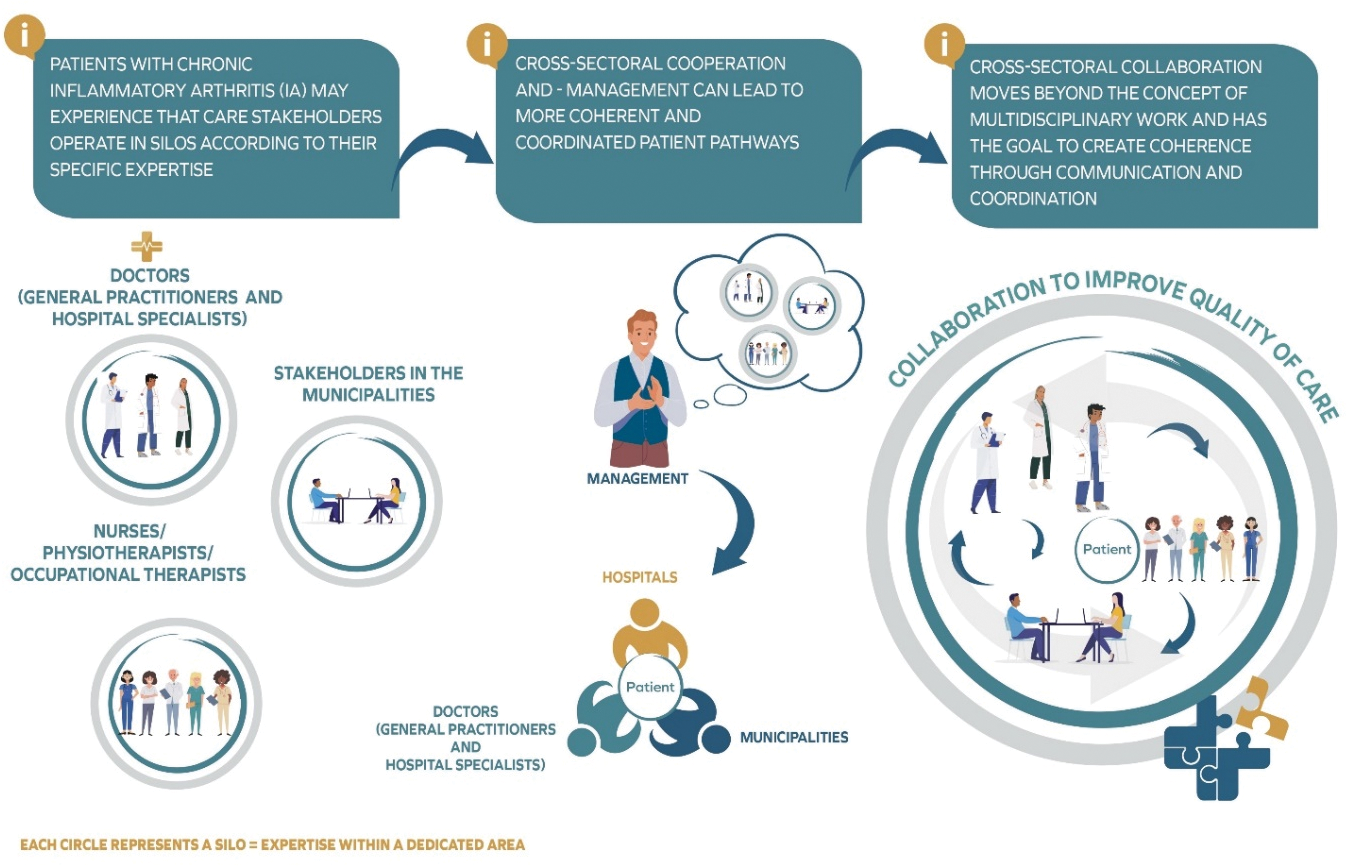

Background: Danish Centre for Expertise in Rheumatology (CeViG) at the Danish Hospital for Rheumatic Disease (DG) in Sønderborg is a unique national institution, which aims at sharing knowledge with stakeholders that play an important professional role for people with inflammatory arthritis (IA). We postulate that co-creation and cross-sectoral cooperation and -management can lead to more coherent and coordinated patient pathways, as it creates more effective and innovative ways to manage the variety of stakeholders and the complexity of IA, ultimately enhancing the quality of healthcare for people with IA. (Figure 1). A one day seminar addressing the need and importance of cross-sectoral cooperation between silos in the health- and social care for people with IA was held in October 2023. The seminar aimed at bringing together a diverse group of stakeholders, including multidisciplinary healthcare professionals, municipal representatives, general practitioners, politicians, public leaders and patient research partners for inspiration and dialogue on how cross-sectoral management can improve and develop the healthcare across sectors for individuals with IA. The content of the seminar delivered state of the art on the latest research on co-creation, public governance, cross-sectoral management and relational capacity.
Objectives: To report the participants’ experience from their participation in the first cross-sectional seminar to enhance coherence across sectors for individuals with IA.
Methods: After the seminar, participants were invited to fill in a feedback form via SurveyXact.
The feedback form contained nine questions. The most important questions highlighted:
how participants perceived the overall benefit from the seminar
to which degree their expectations were met
Results: 53 participants attended the seminar. 28 were external participants, 14 internal participants from CeViG and 11 participants from DG. (Table 1). 22 participants filled in the feedback form. 55% (12/22) responded a ‘Very good’ outcome of the seminar, whilst 45% percent (10/22) experienced the outcome of the seminar as ‘Good’. 59% (13/22) participants responded that the meeting to a ‘High degree’ met their expectations, while 36% (8/22) responded that their expectations were met to a ‘Very high degree’ and 5% (1/22) were neutral.
“The participants’ enthusiasm over the presentations shows that CeViG is on the right track and that there is a pressing need to improve the cross-sectoral cooperation to manage the complexity of patients with IA”.
“The concept relational capacity resonated well with our preconceptions and seem very useful as a tool to improve communication and collaboration both internally in our unit, at the hospital and between the hospital and the municipalities and other external partners”.
Conclusion: The seminar was successful in addressing the need to improve coherence across sectors and the participants responded very positively to the meeting. This is the first step in a continuous process where we aim to involve patients and other stakeholders from all parts of the healthcare system to improve the cross-sectoral cooperation.
Participants’ characteristics
| Participants | N | % | |
|---|---|---|---|
| Internal (CeViG and DG)
| 25
| 47%
|
|
| Municipal representatives | Consultants, physiotherapist, dietician, occupational therapist | 4 | 7,5% |
| Politicians | Committee member, health committee chairman, | 3 | 5,7% |
| Public managers | Head nurse, hospital director, senior project leader, leading physiotherapist, leading bio analyst, leader of health center | 7 | 13,2% |
| Hospital and regional representatives | Doctor, nurse, occupational therapist, physiotherapist, radiographer, secretary, general practitioners, disability consultant, consultants, professor, Ph.D. students | 24 | 45,2% |
| University | Lecturer, professor of healthcare management | 2 | 3,8% |
| Private stakeholders | Board member, consultants, director, communication consultant | 7 | 13,2% |
| Patient research partners | 6 | 11,3% | |
Co-creation and cross-sectoral cooperation enhances coherence and quality of healthcare for individuals with IA.

REFERENCES: NIL.
Acknowledgements: NIL.
Disclosure of Interests: None declared.